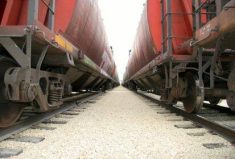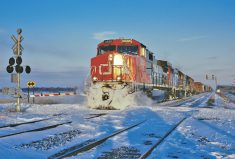Western Canadian grain has been moving fairly well this crop year despite a 76-million-tonne crop and bitterly cold weather, which in 2013-14 was blamed for a huge and expensive grain-shipping backlog.
“All things considered things are going pretty good,” Mark Hemmes, president of Quorum Corporation, the firm hired by the federal government to monitor Western Canada’s grain pipeline, said in an interview Jan. 11. “There is no question that CN (Canadian National Railway) is doing a heck of a lot better than CP (Canadian Pacific Railway) right now. It had some troubles and it is kind of coming out of it.”
Read Also

The joys of fishing from shore
Manitoba has many lake and river shorelines to drop a fishing line without the cost of a boat, making shore fishing more accessible, and anglers can still catch impressive fish.
The recent cold weather, which causes problems with air brakes resulting in shorter trains, has slowed both railways a bit, but CP Rail isn’t meeting the demand for cars as well as CN, according to Wade Sobkowich, executive director of the Western Grain Elevators Association (WGEA), which represents Canada’s major grain companies.
However, the shortfall is nowhere near a “crisis” Sobkowich and Hemmes said in separate interviews.
“But it is concerning, CP’s most recent number, and how far it is behind,” Sobkowich said in an interview Jan. 10.
The Ag Transport Coalition (ATC), which includes the WGEA as a member, was formed to measure railway performance. It reported in week 20 of the 2016-17 crop year, CP Rail delivered only 58 per cent of the cars grain shippers ordered. In week 21 CP Rail supplied 74 per cent of the ordered cars. CP is 932 cars behind, Sobkowich said.
“That’s significant.”
In a statement CP Rail said it’s concerned the ATC isn’t properly measuring its performance. Three-quarters of CP Rail’s grain business is via its Dedicated Train Program (DTP), which gives grain shippers control of cars in Canada and the United States.
“Trying to compare DTP performance to an ‘order fulfilment’ model… simply does not work,” the statement said.
CP Rail said the best way to measure rail performance, which it does weekly, is tonnage.
“CP continues to move volumes consistent with supply chain capacity and remains well positioned to meet the needs of the supply chain,” CP Rail said.
From week eight until week 23, CP Rail moved 8.4 million tonnes of grain, the company said. That’s four per cent less than 2015-16, which was a record year, three per cent above 2014-15 and flat compared to 2013-14, the statement detailed.
Sobkowich said the ATC report captures grain moved through CP Rail’s Dedicated Train Program.
The grain monitor’s week 22 report shows the railways combined have moved 15.64 million tonnes, down just two per cent from 2015-16 and five per cent higher than the five-year average.
Even though the grain-shipping pace is similar to last year, it doesn’t reflect car demand, Sobkowich said. CN Rail is meeting around 95 per cent of the weekly demand, he said. In contrast CP Rail has only supplied shippers with 80 per cent or more of the cars ordered 40 per cent of the time and has hit 90 per cent once.
“CP average weekly on-time order fulfilment performance this year is 77 per cent,” Sobkowich said.
CP Rail has faced challenges, Hemmes said.
“It has had a little bit of a shortage of staff, it got hit with worse weather (than CN). There has been a lot of snow in the mountains so it loses time on transit there,” Hemmes said.
CN Rail has a better route through the mountains, he said.
“They (CN) are running a good railway right now.”
Meanwhile, CP Rail is “perpetually” about 10 trains behind, Hemmes said. That’s equivalent to two ships, but translates into more because not all the grain from one train goes into just two ships.
“That is where the whole thing starts to unwind,” he said. “The point I’m making is this is nowhere near a crisis like in 2013-14, but it does cause a lot of grief for people because it means every anchorage in Vancouver is full (with 27 ships waiting for grain). It means that people are incurring incremental costs that they wouldn’t otherwise because they have to anchor the vessels in what amounts to be a day’s sail away because it is way out in the Georgia Strait.”
Grain is moving relatively well because the railways have less other traffic to haul, Sobkowich said. But Hemmes said improved communications between the railways and grain shippers has helped too. The railways agree.
“Supply chain collaboration has enabled this performance supported by new commercial car supply contracts with reciprocal penalties, which have driven more accountability to supply chain participants,” Kate Fenske, CN Rail’s manager media and community relations said in an email.
“CP has been a collaborative and proactive leader in addressing supply chain capacity challenges related to grain, specifically in Vancouver… ” CP rail said. “Over the last few months CP, in conjunction with customers and terminals, has led the following important changes on the West Coast, including: investing millions to realign track configurations, implementing a revised operating plan, and driving 24-7 accountability.”
Several grain companies have boosted Vancouver’s export capacity through capital investments in their grain terminals, Hemmes said.
“It’s a whole bunch of little things,” he said.
“The flow through the port is much better,” he said. “It is still an issue of getting the cars in the country and getting them to port position.”
The only way to ensure adequate rail service is railway competition, Sobkowich said. To mimic market discipline grain shippers want legislation compelling the railways to enter service agreements with financial penalties when the railways fail to provide agreed-to service.
The WGEA hopes such provisions will be part of the amendments to the Canada Transportation Act the federal government has said it will introduce in Parliament this spring.
The railways say that would discourage investment and make grain transportation less efficient.




















